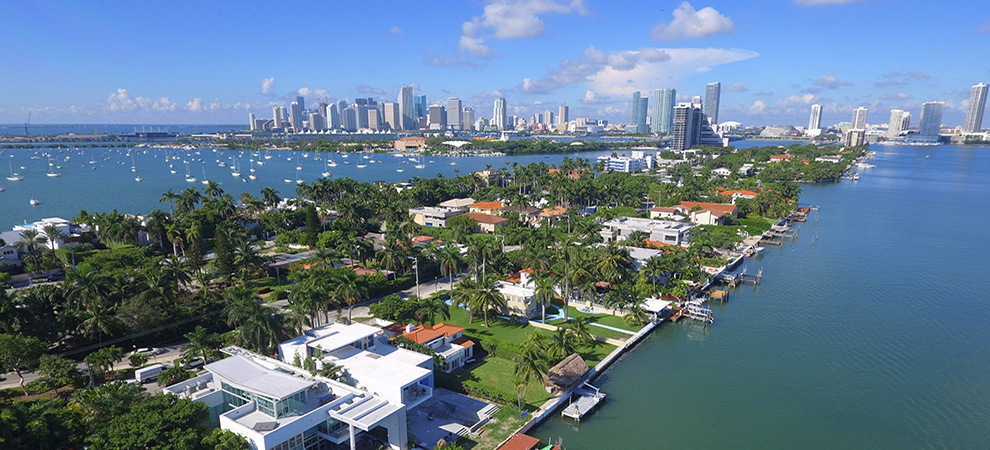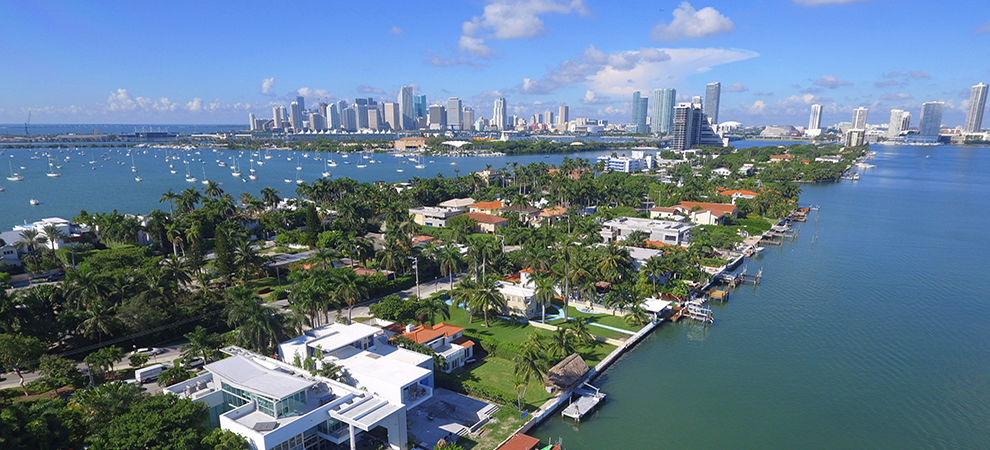
According to the Miami Association of Realtors, luxury home sales in Miami posted double-digit gains while existing condominium transactions surged year-over-year in December 2017.
Luxury ($1 million-and-above) existing Miami condo sales jumped 47.6 percent year-over-year, from 42 to 62. Luxury Miami single-family home sales rose 16.7 percent, from 60 to 70. Existing Miami condo sales increased 6.5 percent year-over-year in December, while single-family transactions stayed effectively even (down 0.7 percent).
"Strong pent-up demand for Miami luxury single-family and condominiums fueled December's strong home sales," said George Jalil, a Miami broker and the 2018 MIAMI chairman of the board. "Luxury sellers are becoming more realistic with their asking prices, and buyers are coming off the sidelines. Federal tax reform is also starting to have an impact as more Northeastern buyers are opting to purchase in Miami to escape the higher taxes they could face in states like New York and New Jersey."
Federal tax reform, which was signed into law Dec. 22, 2017, sets a deductions cap for income, sales and property taxes at $10,000. The new cap could lead more residents of states with high property values and state income tax to purchase properties in states such as Florida, which has no state income tax and a pro-business tax structure.
Total Miami Home Sales, Dollar Volume Increase in December
Total existing Miami-Dade County residential sales -- which posted a record year in 2013 and near record years in 2014 and 2015 -- increased 2.9 percent year-over-year from 2,156 to 2,219.
Miami existing condo sales -- which are competing with one of the most robust new construction markets in the country -- increased 6.5 percent year-over-year, from 1,084 to 1,154. Single-family home sales decreased 0.7 percent, from 1,072 to 1,065.
Lack of access to mortgage loans continues to inhibit further growth of the existing condominium market. Of the 9,307 condominium buildings in Miami-Dade and Broward counties, only 12 are approved for Federal Housing Administration loans, down from 29 last year, according to Florida Department of Business and Professional Regulation and FHA.
Total sales volume for all properties accounted for $983.5 million last month, up 23.2% from $797.9 million a year ago. Sales don't include Miami's multi-billion dollar new construction condo market.
More than Six Consecutive Years of Price Appreciation in Miami
Miami-Dade County single-family home prices increased 9.1 percent in December 2017, increasing from $305,000 to $332,850. Miami single-family home prices have risen for 73 consecutive months, a streak spanning more than six years. Existing condo prices rose 11.9 percent, from $210,000 to $235,000 in December. Condo prices have increased in 76 of the last 79 months.
According to Freddie Mac, the average commitment rate for a 30-year, conventional, fixed-rate mortgage inched higher for the third straight month to 3.95 percent in December from 3.92 percent in November. The average commitment rate for all of 2017 was 3.99 percent.
Miami Distressed Sales Continue to Drop
Only 8.9 percent of all closed residential sales in Miami were distressed last month, including REO (bank-owned properties) and short sales, compared to 14 percent in December 2016. In 2009, distressed sales comprised 70 percent of Miami sales.
Total Miami distressed sales declined 34.4 percent year-over-year, from 302 to 198 last month.
Short sales and REOs accounted for 2.2 and 6.8 percent, respectively, of total Miami sales in December 2017. Short sale transactions dropped 26.2 percent year-over-year while REOs fell 36.7 percent.
Nationally, distressed sales accounted for 5 percent of sales, down from 7 percent a year ago.
Miami Real Estate Selling Close to List Price
The median number of days between listing and contract dates for Miami single-family home sales was 43 days, a 14 percent decrease from 50 days last year. The median number of days between the listing date and closing date for single-family properties was 97 days, an 8.5 percent decrease from 106 days.
The median time to contract for condos rose 16 percent to 87 days from 75 days. The median number of days between listing date and closing date increased 3.3 percent to 127 days.
The median percent of original list price received for single-family homes was 95.6 percent. The median percent of original list price received for existing condominiums was 93.5 percent.
National and State Statistics
Nationally, total existing-home sales slipped 3.6 percent to a seasonally adjusted annual rate of 5.57 million from a downwardly revised 5.78 million in November. After last month's decline, sales are still 1.1 percent above a year ago.
Statewide closed sales of existing single-family homes totaled 22,903 last month, up 2.6 percent compared to December 2016, according to Florida Realtors. Statewide closed condo sales totaled 9,193 last month, up 6 percent compared to December 2016.
The national median existing-home price for all housing types in December was $246,800, up 5.8 percent from December 2016 ($233,300). December's price increase marks the 70th straight month of year-over-year gains.
The statewide median sales price for single-family existing homes last month was $244,185, up 8 percent from the previous year, according to Florida Realtors. The statewide median price for townhouse-condo properties in December was $180,000, up 7.8 percent over the year-ago figure.
Miami's Cash Buyers Represent about Double the National Figure
Miami cash transactions comprised 39.3 percent of December total closed sales, compared to 42.4 percent last year. Miami cash transactions are about double the national figure (20 percent).
Miami's high percentage of cash sales reflects South Florida's ability to attract a diverse number of international home buyers, who tend to purchase properties in all cash. Miami has a higher percent of cash sales for condos due to lack of financing approvals for buildings.
Condominiums comprise a large portion of Miami's cash purchases as 53 percent of condo closings were made in cash in December compared to 24.5 percent of single-family home sales.
Seller's Market for Single-Family Homes, Supply Declines in December 2017
Inventory of single-family homes decreased 4.0 percent in December from 6,218 active listings last year to 5,969 last month. Condominium inventory increased 3.8 percent to 14,436 from 14,984 listings during the same period in 2016.
Monthly supply of inventory for single-family homes decreased 1.8 percent to 5.6 months, which indicates a seller's market. Existing condominiums have a 13.7-month supply, which indicates a buyer's market. A balanced market between buyers and sellers offers between six and nine months supply of inventory.
Total active listings at the end of December increased 1.4 percent year-over-year, from 20,654 to 20,953. Active listings remain about 60 percent below 2008 levels when sales bottomed.
New listings of Miami single-family homes increased 7.9 percent to 1,271 from 1,178. New listings of condominiums increased 3.8 percent, from 14,436 to 14,984.
Nationally, total housing inventory at the end of December dropped 11.4 percent to 1.48 million existing homes available for sale, and is now 10.3 percent lower than a year ago (1.65 million) and has fallen year-over-year for 31 consecutive months. Unsold inventory is at a 3.2-month supply at the current sales pace, which is down from 3.6 months a year ago and is the lowest level since NAR began tracking in 1999.


